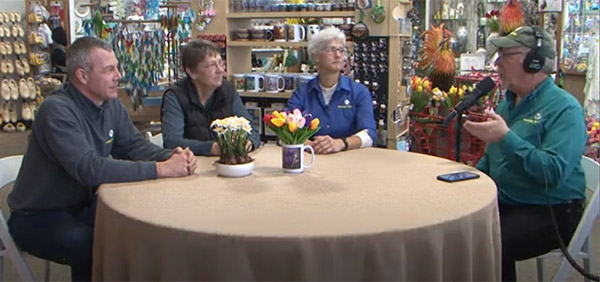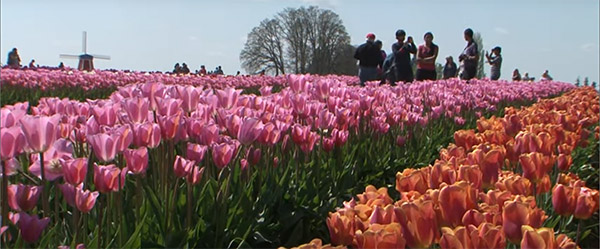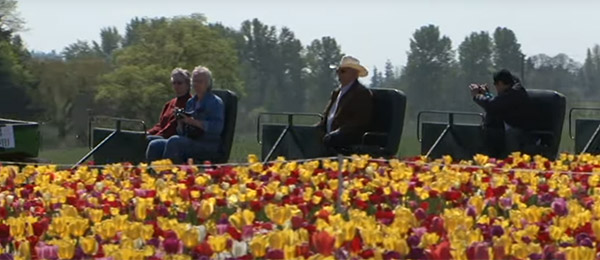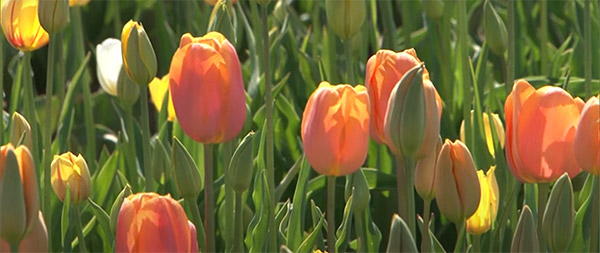|
Season 2 • Episode 5 - March 16, 2023

Spring is a time when gardeners start to get excited
about the warmer, flower-filled months ahead. For many
that excitement starts in a flower field in the
mid-Willamette Valley at the Wooden Shoe Tulip Farm. For
39 years the
Wooden Shoe Tulip Fest and the Iverson family have
welcomed people to their 40-plus acre tulip farm early
each spring to celebrate the tulip. We had a chance to
stop by the farm before the festival started to chat
with Barb Iverson about the history of the Tulip Fest
and growing tulips.
The festival is the signature event for the farm and the
Iversons, but they have been growing tulips for more
than 39 years, since the mid-'70s. They started when
they were approached by a tulip grower from Indiana. The
earlier growing season here in the Northwest was why he
came to talk to them. Growing bulbs is a tough business,
so members of the family got together and decided to
start a little festival to drum up interest in bulb
sales. Their first little festival was not much more
than a wheelbarrow full of tulip bunches and they ended
up with a traffic jam. Being a farming family, they were
surprised at the response. They were also growing
rhododendrons at the same time and slowly got out of
that business to free up more fields for blooms and it
has grown consistently since then. Starting with about
three acres, they now plant between 35 and 40 acres of
bulbs. All those acres means waves of color when you
come out to visit.
Those waves of color are all weather-dependent. Some
years, like this one, the colder weather of the late
winter has slowed down the blooms. The festival for 2023
was supposed to start on the 17th of March, but due to
the cold rains and snow, they had to push the opening
until the 24th of March. Once blooming, they like a
little cooler weather to keep the tulips from blooming
too quickly. The good thing about Wooden Shoe is that
they try to have plenty for people to do when they come
out even if the flowers don’t cooperate. There are lots
of fun activities and things to do for the whole family.
You can always see how the fields are doing by
checking out their website and the updated Field Report.

One of the problems
of the past was the huge crowds that would be attracted
to see the blooms. When COVID-19 pandemic came, they had
to change to a timed ticketing system to keep the crowds
lower. It worked out so well that they have continued to
use that system. Now, instead of waiting in a traffic
jam for hours, you can drive right in and know there
will be a parking spot for you and your family. Plus,
the crowds are smaller so you can enjoy the fields
without a huge crush of humanity to deal with. People
are always aiming to catch the blooms at their peak, but
as Barb told us, there really is no peak. Since there
are so many varieties with differing bloom times you may
have a ‘peak’ of a week or more, once again, depending
on the weather. We were told that the best time to see
the most blooms will occur in April. Always check the
field report to get updated information.
It is a lot of work for the family and all the Wooden
Shoe employees, but there are a lot of perks. One is
just being in the fields every day. The color of the
blooms with the backdrop of snow covered Mt. Hood is
amazing. Then there are the memories that are being
made. Barb loves to see the families with little kids
out in the field and seeing them walking among the
blooms. There is also the reach that this festival has.
There used to be a world map on a wall near the office
and they counted visitors from nearly 140 different
countries one year. The farm figures that there have
been over between 3.5 and 4 million people who have
visited the farm. That’s a lot of smiles over nearly
four decades.

What can you do
once you get your ticket and come out? Well, there are
the fields, of course. Then they have a lot happening
back near the gift shop. They have their own wine, so
you can have a glass or two of that. If you are really
into wines they offer wine tours around the fields and a
tasting of their fabulous vintages. There are a lot of
kids' games and activities, jump tents and carnival
rides, including cow wagons and photo cut-out boards.
There are a lot of onsite food vendors. On weekends you
can see how wooden shoes are made, check out steam
tractor demonstrations and craft vendors. Depending on
the weather you can even book a tethered hot air balloon
ride.
If you fall in love with the tulips, you can purchase
cut flowers to take home or order bulbs to be delivered
next fall so you can plant them and enjoy some of this
great color in your own garden. If you forget to do it
at the festival,
check out their sales page where you can order bulbs
like tulips, daffodils, grape hyacinth, alliums and
crocus.
Once you fall in love with the tulips you will want to
learn a few tips on how to take care of them. First of
all, tulip bulbs do not like wet feet. That means they
don’t like to set in wet or damp conditions. Tulips
really like good drainage. It doesn’t take long for the
bulbs to rot if they are sitting in water. You don’t
have to worry about planting them in a certain
direction. The bulbs don’t have an up or down. They will
grow the right direction no matter which way they are
planted. They also like a little chilling; the bulbs
like a little bit of cold to trigger their spring
growth. As far as pests, rodents love tulips. Mice and
voles will nibble them to get to the tasty center of the
bulb where the new plant is forming. After they bloom in
your garden, then deer become a problem. They love the
blooms for a whole different reason than you! It is a
delicacy for them to eat. Of course, slugs can also be a
problem, eating the leaves and blooms, stunting their
growth. Other than that there are not a lot of pests for
tulips. There is a mold that you might encounter from
moist conditions and it can so fast that it is called
"fire blight." Pick those diseased plants once you see
them and throw them in the garbage to prevent the spread
of the disease.
Once you have them planted you can pretty much leave
them in the ground. Some people want to know if you
should dig them every year, but they are a perennial
bulb so for most locations it is safe to leave them
alone. The only time to dig them is if you are seeing a
lot of foliage and no blooms. The bulbs will multiply
over time and that crowding of the bulbs will cause them
to compete for resources and become weak. Dig them up
after they bloom and separate the bulbs and plant the
extras in a different area in your garden. If you don’t
have room in your garden, remember that tulips are great
for your early spring containers. To help them get
stronger you can deadhead them after they bloom.
Deadheading is when you snap off the old bloom, and the
seed pod that is forming, and leave the foliage. This
allows the foliage to feed nutrients to the bulbs and
helps form the new blooms for next year. If you want to
help them grow you can add a bulb fertilizer. The best
bulb fertilizer is one that doesn’t have a lot of
nitrogen in it. Nitrogen will promote leaf and green
growth. You want the phosphorus to be a little higher
than other nutrients, since that promotes root growth.

For displaying your
cut tulips you will want to give them a fresh cut when
you get them home or from the store. Then get them in
cold water. You don’t need to add anything to the water
to keep them going. in fact, tulips are one of the few
flowers that will continue growing once they have been
cut. The only warning that Barb gave us about displaying
them is to not put them in a vase with fresh cut
daffodils. Daffodils release a sap and if placed in a
vase with tulips they will plug the vascular system of
the tulip and shorten its life. Put your daffodils in
another container for at least a day before you include
them in a vase with your tulips.
So, check out their website and book your tickets to
come out to the fields if you are in the area. If you
live a little further away, be sure to check out their
sales page to get some bulbs for your spring garden.
Kick off your spring with some wonderful color!

PODCASTS
2022
• Return to Current Year Podcast List
 |